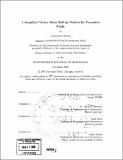A simplified vortex sheet roll-up method for formation flight
Author(s)
Denis, Amandine, 1981-
DownloadFull printable version (9.943Mb)
Other Contributors
Massachusetts Institute of Technology. Dept. of Aeronautics and Astronautics.
Advisor
Earll M. Murman.
Terms of use
Metadata
Show full item recordAbstract
This thesis studies the influence of the roll-up of a wake on the benefits in induced drag and rolling moment experienced by a close formation of two elliptically loaded wings. The roll-up of the leading wake is computed in the Trefftz plane using a linear vorticity panel method. A smoothing parameter as well as a truncation of the vortex sheet in the highly rolled-up areas are introduced in order to stabilize the computations. The trailing wing is simply modeled as a lifting line, and its induced drag is computed thanks to a near-field analysis. The results are compared to computations using simple horseshoe-vortex methods, either with or without a viscous core. Maximum induced drag benefits comprised between 60% and 70% are observed for a lateral overlap of both wings of about 5% to 10% of the span. The maximum rolling moment is in average attained for 1.5% of the span less overlap. It is found that a horseshoe vortex with a viscous core of radius over semi-span ratio (2r[c])/b = 0.12 modeled according to Burnham can account well for the effects of the roll-up of the wake on the benefits in induced drag that can be gained from formation flight. Actually, the difference between both results is mainly confined in a small region around the maximum and the relative error is generally low. Taking the vertical drift of the whole wake into account is not found to be beneficial to the agreement between the results around the maximum. In the case of the rolling moment, the predictions given by simple horseshoe vortex models do not agree very well with the predictions given by the rolled-up sheet model, the relative error between both predictions being very high in many areas.
Description
Thesis (S.M.)--Massachusetts Institute of Technology, Dept. of Aeronautics and Astronautics, 2004. Includes bibliographical references (p. 105-108).
Date issued
2004Department
Massachusetts Institute of Technology. Department of Aeronautics and AstronauticsPublisher
Massachusetts Institute of Technology
Keywords
Aeronautics and Astronautics.